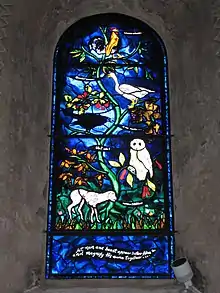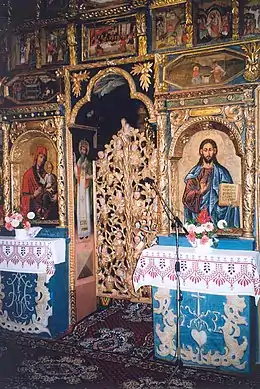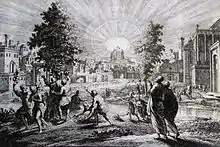Tree of life (biblical)
The tree of life (Hebrew: עֵץ הַחַיִּים Tiberian: ‘êṣ ha-ḥayyîm; Standard: Etz haChayim)[1] is a term mentioned in the Hebrew Bible.
- See also Tree of life for other cultural interpretations, and Tree of life (disambiguation) for other meanings.

In the Book of Genesis, the tree of life is first described in chapter 2, verse 9 as being "in the midst of the Garden of Eden" with the tree of the knowledge of good and evil (Hebrew: עֵץ הַדַּעַת). After the fall of man, "lest he put forth his hand, and take also of the tree of life, and eat, and live for ever",[2] cherubim and a flaming sword are placed at the east end of the Garden to guard the way to the tree of life.[3] The tree of life has become the subject of some debate as to whether or not the tree of the knowledge of good and evil is the same tree.[4]
In the Bible outside of Genesis, the term "tree of life" appears in Proverbs (3:18; 11:30; 13:12; 15:4) and Revelation (2:7; 22:2,14,19). It also appears in 2 Esdras (2:12; 8:52) and 4 Maccabees (18:16), which are included among the Jewish apocrypha.
Number of trees
Karl Budde, in his critical study of 1883, proposed that there was only one tree in the body of the Genesis narrative, and that it had been portrayed in two ways: one as the tree in the middle of the Garden, and two as the forbidden tree. Claus Westermann gave recognition to Budde's theory in 1976.[5]
Ellen van Wolde noted that among Bible scholars "the trees are almost always dealt with separately and not related to each other" and that "attention is almost exclusively directed to the tree of knowledge of good and evil, whereas the tree of life is paid hardly any attention."[6]
Religious views
Christianity

Eastern Christianity

The Eastern Orthodox Church has traditionally understood the tree of life in Genesis as a prefiguration of the Cross, which humanity could not partake of until after the incarnation, death and resurrection of Jesus.[7]
Western Christianity

In The City of God (xiii.20-21), Augustine of Hippo offers great allowance for "spiritual" interpretations of the events in the garden, so long as such allegories do not rob the narrative of its historical reality. Enlightenment theologians (culminating perhaps in Brunner and Niebuhr in the twentieth century) sought for figurative interpretations because they had already dismissed the historical possibility of the story.
Others sought very pragmatic understandings of the tree. In the Summa Theologica (Q97), Thomas Aquinas argued that the tree served to maintain Adam's biological processes for an extended earthly animal life. It did not provide immortality as such, for the tree, being finite, could not grant infinite life. Hence after a period of time, the man and woman would need to eat again from the tree or else be "transported to the spiritual life." The common fruit trees of the garden were given to offset the effects of "loss of moisture" (note the doctrine of the humors at work), while the tree of life was intended to offset the inefficiencies of the body. Following Augustine in the City of God (xiv.26), “man was furnished with food against hunger, with drink against thirst, and with the tree of life against the ravages of old age.”
John Calvin (Commentary on Genesis 2:8), following a different thread in Augustine (City of God, xiii.20), understood the tree in sacramental language. Given that humanity cannot exist except within a covenantal relationship with God, and all covenants use symbols to give us "the attestation of his grace", he gives the tree, "not because it could confer on man that life with which he had been previously endued, but in order that it might be a symbol and memorial of the life which he had received from God." God often uses symbols; he doesn't transfer his power into these outward signs, but "by them He stretches out His hand to us, because, without assistance, we cannot ascend to Him." Thus he intends man, as often as he eats the fruit, to remember the source of his life, and acknowledge that he lives not by his own power, but by God's kindness. Calvin denies (contra Aquinas and without mentioning his name) that the tree served as a biological defense against physical aging. This is the standing interpretation in modern Reformed theology as well.
Judaism
According to Jewish mythology, in the Garden of Eden there is a tree of life or the "tree of souls"[8] that blossoms and produces new souls, which fall into the Guf, the Treasury of Souls. The Angel Gabriel reaches into the treasury and takes out the first soul that comes into his hand. Then Lailah, the Angel of Conception, watches over the embryo until it is born.[9]
Kabbalah
The tree of life is represented in several examples of sacred geometry and is central in particular to the Kabbalah, where it is represented as a diagram of ten points. The ten points are known as Sephiroth or Sephirah, or the ten emanations or attributes of God. Kabbalah is an esoteric method, discipline and school of thought in Jewish mysticism.
See also
References
- Lizorkin-Eyzenberg, Eli (July 7, 2016). "The Power of Hebrew". Israel Study Center. Retrieved March 26, 2017.
- Genesis 3:22
- Genesis 3:24
- Mettinger 2007, pp. 5–11
- Mettinger 2007, p. 7
- Van Wolde, Ellen (1994). Words Become Worlds. Leiden: Brill. p. 32. ISBN 9004098879.
- Roman, Dr. Alexander, Tree of Life in the Garden of Eden, Ukrainian Orthodoxy, archived from the original (– Scholar search) on February 27, 2007
- Scholem, Gershom Gerhard (1990). Origins of the Kabbalah. ISBN 0691020477. Retrieved 2014-05-01.
- "200_ THE TREASURY OF SOULS for Tree of Souls: The Mythology of Judaism". Scribd. Archived from the original on 2012-10-30. Retrieved 15 June 2015.
- Mettinger, Tryggve (2007). The Eden Narrative: A Literary and Religio-historical Study of Genesis 2-3. Eisenbrauns. ISBN 9781575061412.
External links
| Wikimedia Commons has media related to Tree of life (Bible). |
| Wikimedia Commons has media related to Tree of life (Christian). |
Jewish and Non-Jewish views